Chapter 2 Polynomial and Rational Functions
Copyright © 2018 Pearson Education, Inc. 259 259 Copyright © 2018 Pearson Education, Inc.
Section 2.1 Check Point Exercises 1. a. (5 2i)+(3+3i) = 5 2i +3+3i c. 14+ 12 = 14+ i 12 2 2 = 14+2i 3 2 = 14 + 2i 3 2 2 = (5+3)+( 2+3)i =8+ i b. (2+6i) (12 i) = 2+6i 12+ i 5. x 2 2x +2 = 0 a =1, b = 2, c = 2 2 = 7+ i 3 = (2 12)+(6+1)i = 10+7i x = b ± b 4ac 2a 2. a. 7i(2 9i) = 7i(2) 7i(9i) ( 2)± x = ( 2)2 4(1)(2) 2(1) =14i 63i2 =14i 63( 1) = 63+14i x = 2± 4 8 2 b. (5+4i)(6 7i) = 30 35i +24i 28i2 = 30 35i +24i 28( 1) = 30+28 35i +24i = 58 11i x = 2± 4 2 x = 2±2i 2 x =1± i The solution set is {1+ i,1 i} 3. 5+4i = 5+4i ⋅ 4+ i 4 i 4 i 4+ i 20+5i +16i +4i2 = Concept and Vocabulary Check 2.1 16+4i 4i i2 = 20+21i 4 1. 1; 1 16+1 = 16+21i 2. complex; imaginary; real 17 = 16 + 21 i 3. 6i 4. a. 17 17 27 + 48 = i = i 27 + i 9 3+ i 48 16 3 4. 14i 5. 18 ; 15i ; 12i ; 10i2 ; 10 = 3i = 7i 3 +4i 3 3 6. 2 9i 7. 2 5i b. ( 2+ 3)2 = ( 2+ i 3)2
Copyright © 2018 Pearson Education, Inc. 260 260 Copyright © 2018 Pearson Education, Inc. = ( 2)2 +2( 2)(i 3)+(i 3)2 8. i; i; 2i 5 = 4 4i = 4 4i =1 4i 3 +3i2 3 +3( 1) 3 9. 1 i 6 2
Copyright © 2018 Pearson Education, Inc. 261 261 Copyright © 2018 Pearson Education, Inc. Chapter 2 Polynomial and Rational Functions Section 2.1 Complex Numbers Exercise Set 2.1 1. (7 + 2i) + (1 – 4i) = 7 + 2i + 1 – 4i = 7 + 1 + 2i – 4i 14. (8 – 4i)(–3 + 9i) 24 72i 12i 36i2 = –24 + 36 + 84i = 12 + 84i 2. (–2 + 6i) + (4 – i) = –2 + 6i + 4 – i = –2 + 4 + 6i – i = 8 – 2i 15. (3 5i)(3 5i) 9 15i 15i 25i2 9 25 34 = 2 + 5i 3. (3 + 2i) – (5 – 7i) = 3 – 5 + 2i + 7i 16. 2 7i2 7i 4 49i2 4 49 53 = 3 + 2i – 5 + 7i = –2 + 9i 4. (–7 + 5i) – (–9 – 11i) = –7 + 5i + 9 + 11i = –7 + 9 + 5i + 11i = 2 + 16i 5. 6 ( 5 4i) ( 13 i) 6 5 4i 13 i 24 3i 17. 18. ( 5 i)( 5 i) 25 5i 5i i2 25 1 26 ( 7 i)( 7 i) 49 7i 7i i2 49 1 50 2 2 6. 7 ( 9 2i) ( 17 i) 7 9 2i 17 i 33 i 7. 8i – (14 – 9i) = 8i – 14 + 9i 19. 2 3i 4 12i 9i 4 12i 9 5 12i = –14 + 8i + 9i = –14 + 17i 8. 15i – (12 – 11i) = 15i – 12 + 11i = –12 + 15i + 11i = –12 + 26i 20. 5 2i2 25 20i 4i2 25 20i 4 21 20i 2 2 3 i 9. –3i(7i – 5) 21i2 15i 21. 3 i 3 i 3 i = –21(–1) + 15i = 21 + 15i 2(3 i) 9 1 23i 10. –8i (2i – 7) 16i2 56i = –16(–1) + 56i 10 11. 9 25i2 9 25 34= 16 + 56i ( 5 4i)(3 i) 15 5i 12i 4i2 3 i 5 3 1 15 7i 4 19 7i i 5 5 22. 3 3 4 i 12. ( 4 8i)(3 i) 12 4i 24i 8i2 4 i 4 i 4 i
Copyright © 2018 Pearson Education, Inc. 262 262 Copyright © 2018 Pearson Education, Inc. Chapter 2 Polynomial and Rational Functions Section 2.1 Complex Numbers 12 28i 8 4 28i 34 i 16 i2 34 i 13. (7 – 5i)(–2 – 3i) 14 21i 10i 15i2 = –14 – 15 – 11i = –29 – 11i 17 12 3 i 17 17
Chapter 2 Polynomial and Rational Functions Section 2.1 Complex Numbers Copyright © 2018 Pearson Education, Inc. 261 261 Copyright © 2018 Pearson Education, Inc. 2 2 2i 2i 1 i 2i 2i2 2 2i 31. 5 16 3 81 = 5(4i) + 3(9i) 23. 1 i 1 i 1 i 1 i 1 1 2 = 20i + 27i = 47i 24. 5i 5i 2 i 32. 5 8 3 18 2 i 2 i 2 i 5i 8 3i 18 5i 4 2 3i 9 2 10i 5i2 4 1 10i 19i 2 9i 2 2 25. 5 10i 5 1 2i 8i 8i 4 3i 33. 2 4 2 2i2 4 8i 4i2 = 4 – 8i – 4 4 3i 4 3i 4 3i = –8i 32i 24i2 16 9 34. 5 9 ( 5 i 9)2 5 3i2 24 32i 25 25 30i 9i2 24 32 i 25 25 = 25 + 30i – 9 = 16 + 30i 2 2 6i 6i 3 2i 18i 12i2 35. 3 7 3 i 7 26. 3 2i 3 2i 3 2i 9 4 9 6i 7 i2 7 12 18i 12 18 i 13 13 13 9 7 6i 7 27. 2 3i 2 3i 2 i 2 6i 7 2 2 2 i 2 i 2 i 36. 2 11 2 i 11 4 4i 3i2 4 1 4 4i 11 i2 11 7 4i 4 11 4i 11 5 7 4 i 7 4i 11 5 5 37. 8 32 8 i 32
Chapter 2 Polynomial and Rational Functions Section 2.1 Complex Numbers Copyright © 2018 Pearson Education, Inc. 262 262 Copyright © 2018 Pearson Education, Inc. 28. 3 4i 3 4i 4 3i 24 24 8 i 16 2 4 3i 4 3i 4 3i 12 25i 12i2 16 9 25i 25 i 24 8 4i 2 24 1 2 i 3 6 29. 64 25 i 64 i 25 38. 12 28 12 i 28 12 i 4 7 8i 5i 3i 32 32 32 12 2i 7 3 7 i 30. 81 144 i 81 i 144 = 9i – 12i 32 8 16 = –3i
Chapter 2 Polynomial and Rational Functions Section 2.1 Complex Numbers Copyright © 2018 Pearson Education, Inc. 263 263 Copyright © 2018 Pearson Education, Inc. 39. 6 12 6 i 12 45. x 2 6x 10 0 48 48 6 i 4 3 48 6 2i 3 48 1 3 i 8 24 6 ( 6)2 4(1)(10) x 2(1) x 6 36 40 2 x 6 4 2 x 6 2i 2 40. 15 18 15 i 18 15 i 9 2 33 33 33 15 3i 2 5 2 i 33 11 11 46. x 3 i The solution set is 3 i,3 i x 2 2x 17 0 41. 8 3 5 i 8(i 3 5) 2 ( 2)2 4(1)(17) x 2(1) 2i 2 i 3 5 2 4 68 2 6 2i 10 x 2 2 64 42. 12 4 2 i 12(i 4 2) x 2 2i 4i2 32i 2 3 2i 6 x 2 8i 2 x 1 4i 4 3 2i 6 The solution set is {1 4i,1 4i} 43. 3 5 4 12 3i 5 8i 3 47. 4x 2 8x 13 0 24i2 15 24 15 8 x 82 4(4)(13) 2(4) 44. 3 72 8 8 64 208 8 8 144 (3i 7)(2i 8) (3i 7)(2i 4 2) 8 3i 74i 2 12i2 14 12 14 8 12i 8 4( 2 3i)
Chapter 2 Polynomial and Rational Functions Section 2.1 Complex Numbers Copyright © 2018 Pearson Education, Inc. 264 264 Copyright © 2018 Pearson Education, Inc. 8 2 3i 2 1 3 i 2 The solution set is 1 3 i, 1 3 i 2 2
Chapter 2 Polynomial
Section 2.1 Complex Numbers Copyright © 2018 Pearson Education, Inc. 265 265 Copyright © 2018 Pearson Education, Inc. 48. 2x 2 2x 3 0 50. 3x 2 4x 6 0 (2) x (2)2 4(2)(3) 2(2) ( 4) x ( 4)2 4(3)(6) 2(3) 2 4 24 4 2 20 4 2 2i 5 4 2( 1 i 5) 4 1 i 5 2 1 5 i 4 16 72 6 4 56 6 4 2i 14 6 2(2 i 14) 6 2 i 14 3 2 14 i 2 2 3 3 The solution set is 1 5 1 5 i, i 2 2 2 2 The solution set is 2 14 2 14 3 3 i, 3 3 i . 49. 3x 2 8x 7 0 8 ( 8)2 4(3)(7) 51. 2 3i1 i 3 i3 i 2 2i 3i 3i2 32 i2 x 2(3) 8 64 84 6 8 20 6 8 2i 5 2 5i 3i2 9 i2 7 5i 4i2 7 5i 4 1 11 5i 52. 8 9i2 i 1 i1 i 6 16 8i 18i 9i2 12 i2 2(4 i 5) 6 16 10i 9i2 1 i2 2 4 i 5 3 4 5 i 3 3 15 10i 8i 15 10i 8 1 23 10i 2 2 The solution set is 4 5 4 5 3 3 i, 3 3 i 53. 2 i 3 i 4 4i i2 9 6i i2 4 4i i2 9 6i i2 5 10i
and Rational Functions
Chapter 2 Polynomial and Rational Functions Section 2.1 Complex Numbers Copyright © 2018 Pearson Education, Inc. 266 266 Copyright © 2018 Pearson Education, Inc. 54. 4 i2 1 2i2 16 8i i2 1 4i 4i2 59. f x x 2 19 2 x 3i 2 19 16 8i i2 1 4i 4i2 15 12i 3i2 15 12i 3 1 f 3i 2 3i 9i2 19 2 3i 18 12i 9 19 2 3i 55. 5 16 3 81 10 5 16 1 3 81 1 2 3i 5 4i 3 9i 10 2 3i 20i 27i 2 3i 2 3i 47i or 0 47i 20 30i 4 9i2 56. 5 8 3 18 20 30i 4 9 5 4 2 1 3 9 2 1 20 30i 5 2 2 i 3 3 2 i 13 10i 2 9i 2 20 30 i 10 9i 2 13 13 19i 2 or 0 19i 2 60. f x x 2 11 3 x 57. f x x 2 2x 2 2 2 4i 11 16i 11 f 1 i 1 i2 21 i 2 f 4i 3 4i 3 4i 1 2i i2 2 2i 2 1 i2 1 1 0 16 11 3 4i 5 3 4i 5 3 4i 3 4i 3 4i 58. f x x 2 2x 5 f 1 2i 1 2i2 21 2i 5 15 20i 9 16i2 1 4i 4i2 2 4i 5
Chapter 2 Polynomial and Rational Functions Section 2.1 Complex Numbers Copyright © 2018 Pearson Education, Inc. 267 267 Copyright © 2018 Pearson Education, Inc. 4 4i2 15 20i 9 16 15 20i 4 4 25 0 15 20 i 25 25 3 4 i 5 5
75. does not make sense; Explanations will vary.
Sample explanation: i 1 ; It is not a variable in this context.
76. makes sense
77. false; Changes to make the statement true will vary. A sample change is: All irrational numbers are complex numbers.
78. false; Changes to make the statement true will vary. A sample change is: (3
= 58 which is a real number.
79. false; Changes to make the statement true will vary. A
Chapter 2 Polynomial and Rational Functions Section 2.1 Complex Numbers
© 2018
Education, Inc. 268 268 Copyright
Education,
61. E IR 4 5i3 7i 12 28i 15i 35i2 12 13i 35 1 12 35 13i 47 13i The voltage of the circuit is (47 + 13i) volts.
Copyright
Pearson
© 2018 Pearson
Inc.
7
)(3 – 7i
= 9
49
+
i
)
+
sample change
7 3i 7 3i 5 3i 44 6i 22 3 i 62. E IR 2 3i3 5i 6 10i 9i 15i2 6 i 15 1 5 3i 80. true 5 3i 5 3i 34 17 17 6 i 15 21 i The voltage of the circuit is 21 i volts. 63. Sum: 5 i 15 5 i 15 4 4 81. 2 i3 i 6 2i 3i i2 4 6 i 1 4 7 i 5 i 15 5 5 10 Product: 5 i 15 4 7 i 7 i 7 i 28 4i 49 i2 5 i 15 5 i 15 25 5i 15 5i 15 15i2 28 4i 49 1 25 15 40 64. – 72. Answers will vary. 73. makes sense 74. does not make sense; Explanations
Sample explanation: Imaginary numbers are not 82. 28 4i 50 28 4 i 50 50 14 2 i 25 25 1 i 1 i undefined. 1 2i 1 2i 1 i1 2i 1 i1 2i
is:
will vary.
1 2i1 2i 1 2i1 2i 1 i1 2i 1 i1 2i 1 2i1 2i 1 2i i 2i2 1 2i i 2i2 1 4i2 1 2i i 2 1 2i i 2 1 4 6 5 6 0i 5
89. The graph of g is the graph of f shifted 1 unit up and 3 units to the left.

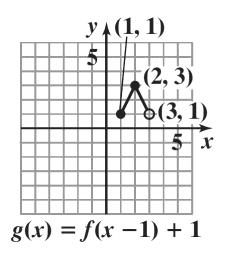
Chapter 2 Polynomial
Section 2.1 Complex Numbers Copyright © 2018 Pearson Education, Inc. 269 269 Copyright © 2018 Pearson Education, Inc. 8 8 88. x 2 2x 1 0 83. 2 i 2 1 x 2 2x 1 0 i i i 8 2 i b b2 4ac x 2a i 8i 2 i ( 2) x 2 8 ( 2)2 4(1)( 1) 2(1) 8i 2 i 2 2 i 2 i 16i 8i2 4 i2 2 2 2 2 1 2 16i 8 4 1 The solution set is {1 2} 8 16i 5 8 16 i 5 5 84. domain: [0,2) range: [0,2]
and Rational Functions
85. 86. f (x) =1 at 1 2 and 3 . 2 87. 0 2(x 3)2 8 2(x 3)2 8 (x 3)2 4 x 3 4 x 3 2 x 1, 5
Section 2.2 Check Point Exercises
Step 1: The parabola opens down because a < 0.
Step 1: The parabola opens down because a < 0. Step 2: find the vertex: (1, 4) Step
find the x-intercepts:
Step 5: The axis of symmetry is x = 1.
The x-intercepts are x ≈ 0.2 and x ≈ 4.2.


Step 4: find the y-intercept: f (0)= 02 +4(0)+1=1
Step 5: The axis of symmetry is x = 2.
2. f ( x)=( x 2)2 +1
Step 1: The parabola opens up because a > 0.
Step 2: find the vertex: (2, 1)
Step 3: find the x-intercepts:
0 =( x 2)2 +1
4. f (x) = 4x 2 16x +1000
a. a = 4. The parabola opens upward and has a minimum value.
( x 2)2 = 1 b 16
b. x = = = 2
x 2 = 1 2a 8 x = 2± i
The equation has no real roots, thus the parabola has no x-intercepts.
Step 4: find the y-intercept:
f (0)=(0 2)2 +1= 5
Step 5: The axis of symmetry is x = 2.
f (2) = 4(2)2 16(2)+1000 = 984
The minimum point is 984 at x = 2
c. domain: ( ∞ , ∞) range: [984,∞)
Copyright ©
Pearson Education, Inc. 270 270 Copyright
Education, Inc. Section 2.2 Quadratic Functions Chapter 2 Polynomial and Rational Functions
2018
© 2018 Pearson
3. f (x)= x 2 +
4x +1
1. f ( x)= ( x 1)2 +4 b 4 x = = = 2 a= 1 h=1 2 k=4 2a 2( 1) f ( x)= x 1 + 4 f (2)= 22 +4(2)+1= 5 The vertex is (2, 5).
Step 2: find the vertex:
3:
0 = ( x 1)2 +4
3:
0 = x 2 +4x +1 b ± b2 4ac x = 2a ( x 1)2 = 4 x 1=±2 x =1±2 4± x = 42 4( 1)(1) 2( 1) x = 3 or x = 1
4:
y-intercept: x = 4± 20 2 f (0)= (
x = 2± 5
Step
find the x-intercepts:
Step
find the
0 1)2 +4 = 3

Copyright © 2018 Pearson Education, Inc. 271 271 Copyright © 2018 Pearson Education, Inc. Section 2.2 Quadratic Functions Chapter 2 Polynomial and Rational Functions
and Rational Functions
f ( x)= 4 ( x 1)2
f ( x)= ( x 1)2 +4
vertex: (1, 4)
x-intercepts:
0 = ( x 1)2 +4
( x 1)2 = 4
x – 1 = ±2
x = –1 or x = 3
y-intercept:
f ( x)= (0 1)2 +4 = 3
The axis of symmetry is x = 1.
domain: ( ∞ , ∞)
range: ( ∞ ,4]
f ( x)=1 ( x 3)2
f ( x)= ( x 3)2 +1
vertex: (3, 1)
x-intercepts:
0 = ( x 3)2 +1 ( x 3)2 =1
x – 3 = ± 1
x = 2 or x = 4
y-intercept:
f (0)= (0 3)2 +1= 8
The axis of symmetry is x = 3.
domain: ( ∞ , ∞)
range: ( ∞,1]
27. 28.
f ( x)= x 2 2x 3
f ( x)=(x 2 2x +1) 3 1
f ( x)=( x 1)2 4
vertex: (1, –4)




x-intercepts:
0 =( x 1)2 4
( x 1)2 = 4
x – 1 = ±2
x = –1 or x = 3
y-intercept: –3
f (0)= 02 2(0) 3 = 3
The axis of symmetry is x = 1.
domain: ( ∞ , ∞)
range: [ 4,∞)
f (x)= x 2 2x 15
f (x)=(x 2 2x +1) 15 1
f (x)=(x 1)2 16
vertex: (1, –16)
x-intercepts:
0 =( x 1)2 16
( x 1)2 =16
x – 1 = ± 4
x = –3 or x = 5
y-intercept:
f (0)= 02 2(0) 15 = –15
The axis of symmetry is x = 1.
domain: ( ∞ , ∞)
range: [ 16,∞)
274 Copyright © 2018 Pearson Education, Inc. Copyright © 2018 Pearson Education, Inc.
Section 2.2 Quadratic Functions
2
Chapter
Polynomial
274


Section 2.2 Quadratic Functions Chapter 2 Polynomial and
275 Copyright © 2018 Pearson Education, Inc. Copyright © 2018 Pearson Education, Inc. 275 2 = ± 29. f ( x)= x 2 +3x 10 x-intercepts: f ( x)= x 2 +3x + 9 10 9 0 = 2 7 2 81 x 4 4 4 8 2 f ( x)= x + 3 49 7 2 81 2 4 2 x 4 = 8 vertex: 3 , 49 7 2 81 2 4 x = x-intercepts: 4 16 0 = x + 3 2 49 4 x 7 =± 9 4 4 7 9 x + 3 2 = 49 x = ± 4 4 2 4 x 1 or x = 4 x + 3 =± 7 2 2 2 y-intercept: 2 3 7 x = 2 2 f (0)= 2(0) 7(0) 4 = –4 x = 2 or x = –5 y-intercept: f ( x)= 02 +3(0) 10 = 10 The axis of symmetry is x 3 . The axis of symmetry is x = 7 . 4 = 2 domain: ( ∞ , ∞) range: 81 , ∞ 8 domain: ( ∞ , ∞) range: 49 , ∞ 31. f (x) = 2x x 2 +3 4 2 30. f ( x)= 2x 2 7x 4 f (x) = x f (x) = (x +2x +3 2 2x +1)+3+1 f ( x)= 2 x 2 7 x + 49 4 49
Rational Functions
Section 2.2 Quadratic Functions Chapter 2 Polynomial and Rational Functions 276 Copyright © 2018 Pearson Education, Inc. Copyright © 2018 Pearson Education, Inc. 276 4 4 8 f (x) = ( x 1)2 +4 vertex: (1, 4) 2 16 8 x-intercepts: f ( x)= 2 x 7 2 81 8 0 = ( x 1)2 +4 ( x 1)2 = 4 vertex: 7 , 81 x – 1 = ±2 x = –1 or x = 3 y-intercept: f (0)= 2(0) (0)2 +3 = 3 The axis of symmetry is x = 1.




Section 2.2 Quadratic Functions Chapter 2
277 Copyright © 2018 Pearson Education, Inc. Copyright © 2018 Pearson Education, Inc. 277 ( x +3)2 = 6 x +3 =± 6 x = 3± 6 y-intercept: domain: ( ∞ , ∞) range: ( ∞ ,4] f (0) = (0)2 +6(0)+3 f (0) = 3
axis of symmetry is x = 3 32. f (x) = 5 4x x 2 f (x) = x 2 4x +5 f (x) = ( x 2 +4x +4)+5+4 f (x) = ( x +2)2 +9 vertex: (–2, 9) x-intercepts: 0 = ( x +2)2 +9 34. domain: ( ∞ , ∞) range: [ 6,∞) f (x) = x 2 +4x 1 f (x) = (x 2 +4x +4) 1 4 2 ( x +2)2 = 9 x + 2 = ± 3 x = –5, 1 y-intercept: f (0) = 5 4(0) (0)2 = 5 f (x) =( x +2) 5 vertex: ( 2, 5) x-intercepts: 0 =( x +2)2 5 ( )2 x +2 = 5 The axis of symmetry is x = –2. x +2 =± 5 x = 2± 5 y-intercept: domain: ( ∞ , ∞) range: (−∞,9]
(0)
axis of symmetry is x = 2 . 33. f (x) = x 2 +6x +3 f (x) = (x 2 +6x +9)+3 9 f (x) =( x +3)2 6 vertex: (
)
-intercepts: 0 =( x +3)2 6
Polynomial and Rational Functions
The
f (0) = (0)2 +4(0) 1 f
= 1 The
3, 6
x
Section 2.2 Quadratic Functions Chapter 2 Polynomial and Rational Functions 278 Copyright © 2018 Pearson Education, Inc. Copyright © 2018 Pearson Education, Inc. 278 dom ain: ( ∞ , ∞) ran ge: [ 5, ∞)


Section 2.2 Quadratic Functions Chapter 2 Polynomial and Rational Functions 279 Copyright © 2018 Pearson Education, Inc. Copyright © 2018 Pearson Education, Inc. 279 3 3 3 35. f (x) = 2x 2 +4x 3 f (x) = 2(x 2 +2x ) 3 3 x 1 3 2 13 = 3 f (x) = 2(x 2 +2x +1) 3 2 f (x) = 2( x +1)2 5 x 1 3 2 13 = 9 vertex: ( 1, 5) x 1 =± 13 x-intercepts: 0 = 2( x +1)2 5 3 9 x = 1 ± 13 3 3 2( x +1)2 = 5 ( x +1)2 = 5 2 x +1=± 5 2 y-intercept: f (0) = 3(0)2 2(0) 4 f (0) = 4 The axis of symmetry is x = 1 3 x = 1± 10 2 y-intercept: f (0) = 2(0)2 +4(0) 3 f (0) = 3 The axis of symmetry is x = 1 domain: ( ∞ , ∞) range: 13 , ∞ 3 36. domain: ( ∞ , ∞) range: [ 5,∞) f (x) = 3x 2 2x 4 f (x) = 3 x 2 2 x 4 37. f (x) = 2x x 2 2 f (x) = x 2 + 2x 2 f (x) = (x 2 2x +1) 2 +1 f (x) = (x 1)2 1 vertex: (1, –1) x-intercepts: 0 = (x 1)2 1 3 f (x) = 3 x 2 2 x + 1 4 1 (x 1)2 = 1 3 9 3 x – 1 = ±i f (x) = 3 x 1 2 13 3 x = 1 ±i No x-intercepts y-intercept: vertex: 1 , 13 x-intercepts: f (0) = 2(0) (0)2 2 = 2
Section 2.2 Quadratic Functions Chapter 2 Polynomial and Rational Functions 280 Copyright © 2018 Pearson Education, Inc. Copyright © 2018 Pearson Education, Inc. 280 3 0 = 3 x 1 2 13 3
The axis of symmetry is x = 1. 40. f(x) = 2x 2 – 8x – 3
a. a = 2. The parabola opens upward and has a minimum value.
b. x = b = 8 = 2
a 4 f(2) = 2(2)2 – 8(2) – 3 = 8 – 16 – 3 = –11


a. a = -4 The parabola opens downward and has a maximum value.
(1) = 4(1)2 +8(1) 3 = 4+8 3 =1
( ∞
a. a = –2. The parabola opens downward and has a maximum value.
f(–3) = –2(–3)2 – 12(–3) + 3 = –18 + 36 + 3 = 21
The maximum is 21 at x = 3 .
c. domain: ( ∞ , ∞) range: ( ∞ ,21]
43. f (x) = 5x 2 5x
a. a = 5. The parabola opens upward and has a minimum value.
b. x = b = 5 = 1
281 Copyright © 2018 Pearson Education, Inc. Copyright © 2018 Pearson Education, Inc.
Section 2.2 Quadratic Functions
2 Polynomial
281 2
Chapter
and Rational Functions
2
range:
41. c.
f (x) = 4x 2 +8x 3 range:
38. f (x) = 6 4x + x 2
The minimum is –11 at x = 2 domain: ( ∞ , ∞)
( ∞ , 1]
domain: ( ∞ , ∞)
[ 11,∞)
(x) = x 2 4x +6 b.
2
x)
x 2 4x +4)+6 4
x) =( x 2)2 +2 f
vertex:
2) x-intercepts: 0 =( x 2)2 +2
f
x = b = 8 =1
a 8 f (
=(
f (
The maximum is 1 at x =1.
(2,
–
x
( x 2)2 = 2
c. domain:
, ∞) 42. f(x) = –2x2
12
+ 3 range: ( ∞,1]
x 2 =±i 2 b 12 x = 2± i 2 b. x = = = 3 2a 4 No
-intercepts y
x
-intercept: f (0) = 6 4(0)+(0)2 = 6 The axis of symmetry is x = 2.
2a f 1 = 5 1 10 2 5 1 range: [2,∞) 2 2 5 2 5 5
domain: ( ∞ , ∞)
Section 2.2 Quadratic Functions
2
Education, Inc.
Education, Inc. 282
–
= 5 = 10 = 4 2 4 4 4
The minimum is 5 4 at x = 1 . 2
5 2a 6 c. domain: ( ∞ , ∞) range: 4 , ∞
–
= –
The
Chapter
Polynomial and Rational Functions 282 Copyright © 2018 Pearson
Copyright © 2018 Pearson
39. f(x) = 3x 2 – 12x
1
a. a = 3. The parabola opens upward and has a minimum value.
b. x = b = 12 = 2
f(2) = 3(2)2 – 12(2) – 1 = 12 – 24
1
13
minimum is –13 at x = 2 c. domain: ( ∞ , ∞) range: [ 13,∞)
45. Since the parabola opens up, the vertex ( 1, 2) is a minimum point. domain: ( ∞ , ∞) range: [ 2,∞)
46. Since the parabola opens down, the vertex ( 3, 4) is a maximum point.
domain: ( ∞ , ∞). range: ( ∞ , 4]
47. Since the parabola has a maximum, it opens down from the vertex (10, 6)
domain: ( ∞ , ∞) range: ( ∞ , 6]
48. Since the parabola has a minimum, it opens up from the vertex ( 6,18)
domain: ( ∞ , ∞) range: [18,∞)
49. (h, k )=(5,3)
55. Since the vertex is a minimum, the parabola opens up and a = 3
)
f ( x)= 3( x h)2 + k = 3( x 11)2 +0
= 3( x 11)2
56. Since the vertex is a minimum, the parabola opens up and a = 3.
(h,k )=(9,0)
f ( x)= 3( x h)2 + k
= 3( x 9)2 +0
= 3( x 9)2
Section 2.2 Quadratic Functions Chapter 2 Polynomial
283 Copyright © 2018 Pearson Education, Inc. Copyright © 2018 Pearson Education, Inc. 283 6
f (x) = 6x 2 6x
minimum value. 52. (h,k )=( 8, 6) f ( x)= 2( x h)2 + k = 2[x ( 8)]2 +( 6) = 2( x +8)2 6 b. x = b = 6 = 1 2a 12 2 53. Since the vertex is a maximum, the parabola opens 1 1 2 f = 6 1 down and a = 3 (h, k )=( 2,4) 2 2 2 = 6 3 = 3 6 = 3 4 2 2 2 f ( x)= 3( x h)2 + k = 3[x ( 2)]2 +4 The minimum is 3 2 at x = 1 2 = 3( x +2)2 +4 54.
vertex
maximum,
parabola opens c. domain: ( ∞ , ∞) range: 3 , ∞ down and a = 3. 2
and Rational Functions
44.
a. a = 6. The parabola opens upward and has
Since the
is a
the
(h,k )=(5, 7) f ( x)= 3( x h)2 + k = 3( x 5)2 +( 7) = 3( x 5)2 7
(h, k )
=(11,0
f ( x)= 2( x h)2 + k = 2( x 5)2 +3
a. y = 0.01x 2 +0 7x +6.1 a = 0 01, b = 0 7, c = 6.1 50. (h, k )=(7,4) f ( x)= 2( x h)2 + k = 2( x 7)2 +4 x-coordinate of vertex
=
35 2a
) 51. (h, k )=( 10, 5) y-coordinate of vertex 2 f ( x)= 2( x h)2 + k y = 0 01x +0.7x +6.1 2
57.
= b
0.7 =
2( 0.01
The
Section 2.2 Quadratic Functions Chapter 2 Polynomial and Rational Functions 284 Copyright © 2018 Pearson Education, Inc. Copyright © 2018 Pearson Education, Inc. 284 = 2[x ( 10)]2 +( 5) y = 0 01(35) +0.7(35)+6.1=18 35 = 2( x +10)2 5
maximum height
18.35 feet.
occurs 35 feet
its point of release.
of the shot is about
This
from
b. The ball will reach the maximum horizontal distance when its height returns to 0.
a. The information needed is found at the vertex.
c. The initial height can be found at x = 0.
= 0.01x 2 +0.7x +6.1
= 0.01(0)2 +0.7(0)+6.1= 6.1
shot was released at a height of 6.1 feet.
7.8).
This occurs 1.5 feet from its release.
b. The ball will hit the ground when the height reaches 0.
= 0.8x 2 +2.4x +6
The ball travels 4.6 feet before hitting the ground.
c. The starting point occurs when x = 0. Find the corresponding y-coordinate.
The maximum height of the shot is about 33.7 Plot
feet. This occurs 26.25 feet from its point of release.
b. The ball will reach the maximum horizontal distance when its height returns to 0. y = 0.04x 2 +2.1x +6.1
connect them with a smooth curve. a
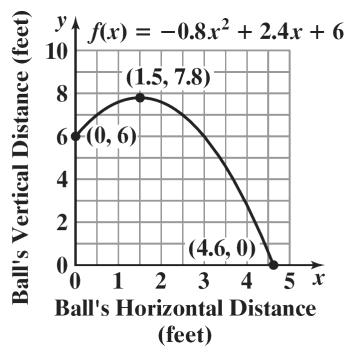
Section 2.2 Quadratic Functions Chapter 2 Polynomial and
285 Copyright ©
Pearson Education, Inc.
Education, Inc. 285
Rational Functions
2018
Copyright © 2018 Pearson
y =
x
0 = 0.01x 2 +0.7x
6.1
0.01x 2 +0 7
+6.1
+
59. y = 0.8x 2 +2.4x +6
x-
a = 0 01, b = 0 7, c = 6.1 x = b = 2.4 =1.5 b ± b2 4ac 2a 2( 0.8) x = 0.7± x = 2a 0.72
2( 0.01)
-coordinate
The vertex
x ≈ 77.8 or x ≈ 7 8 The maximum
coordinate of vertex
4( 0.01)(6.1)
y
of vertex y = 0.8(1.5)2 +2.4(1.5) +6 = 7.8
is (1.5,
height of the ball is 7.8 feet. The maximum horizontal distance is 77.8 feet.
y
The
y
0
b ± b2 4ac x = 58. a. y = 0.04x 2 +2.1x +6.1 2a a = 0 04, b = 2 1, c = 6.1 2.4± 2.42 4( 0.8)(6) x = x-coordinate of vertex = b = 2.1 = 26 25 x ≈ 1.6 or 2( 0.8) x ≈ 4.6 2a 2( 0.04) y-coordinate of vertex y = 0.04x 2 +2.1x +6.1 y = 0.04(26.25)2 +2 1(26 25)+6.1≈ 33.7
y
= 0.8x 2 +2.4x +6
y = 0.8(0)
2 +2 4(0)+6 = 6
0,6
1 5,7
4.7,0
(
), (
8), and (
), and
0
= 0.04x 2 +2 1x +6.1
= 0.04, b
b
2.1, b2 4ac
6.1 x = 2.1± x = 2a 2.12 4( 0.04)(6.1) 2( 0 04) x ≈ 55.3 or x ≈ 2.8 60. y = 0.8x 2 +3.2x +6
±
=
c =
The maximum horizontal distance is 55.3 feet.
c. The initial height can be found at x = 0.
y = 0.04x 2 +2.1x +6.1
y = 0.04(0)2 +2 1(0)+6.1= 6.1
The shot was released at a height of 6.1 feet.
a. The information needed is found at the vertex.
x-coordinate of vertex
x = b = 3 2 = 2
2a 2( 0 8)
y-coordinate of vertex
y = 0.8(2)2 +3.2(2)+6 = 9.2
The vertex is (2, 9 2).
The maximum height of the ball is 9 2 feet
This occurs 2 feet from its release.
2018 Pearson Education, Inc.
Section 2.2 Quadratic Functions Chapter 2 Polynomial
286
and Rational Functions 286 Copyright © 2018 Pearson Education, Inc. Copyright ©
b. The ball will hit the ground when the height reaches 0.
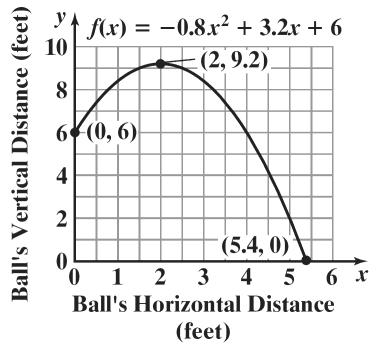
63. Let x = one of the numbers; x 16 = the other number.
The
The vertex is (8, 64) . The minimum product is 64. The ball travels 5 4 feet before hitting the ground
This occurs when the two numbers are 8 and 8 16 = 8 .
c. The starting point occurs when x = 0. Find the corresponding y-coordinate
64. Let x = the larger number. Then x 24 is the smaller number. The product of these two numbers is given by Plot (0,6), (2,9.2), and (5 4,0), and connect
them with a smooth curve.
6
The product is minimized when
61. Let x = one of the numbers; 16 x = the other number.
The x-coordinate of the maximum is
16
The vertex is (8, 64) The maximum product is 64 This occurs when the two numbers are 8 and 16 8 =8 .
62. Let x = one of the numbers Let 20 – x = the other number
Since 12 ( 12)= 24, the two numbers whose difference is 24 and whose product is minimized are 12 and 12
The minimum product is P(12) =12(12 24)= 144.
65. Maximize the area of a rectangle constructed along a river with 600 feet of fencing. Let x = the width of the rectangle; 600 2x = the length of the rectangle We need to maximize.
Since a = 2 is negative, we know the function opens downward and has a maximum at
Section 2.2 Quadratic Functions Chapter 2 Polynomial and Rational Functions 287
287
Copyright © 2018 Pearson Education, Inc. Copyright © 2018 Pearson Education, Inc.
y = 0.8x 2
3.2
product
f ( x)= x( x 16)= x 2 16x 0 = 0.8x 2 +3.2x +6 b ± b2 4ac
+
x +6 The
is
x-
b 16 16 x = = = = 8. x = 3.2± x = 2a 3.22 4( 0 8)(6) 2a f (8)=(8)2 2(1) 2 16(8) x ≈ 1.4
x ≈
= 64
=
coordinate of the minimum is
or 2( 0.8)
5.4
128
64
y =
0.8(0)2 +3.2(0)+6 =
P(x) = x( x 24)= x 2 24x
b ( 24) x = = =12 2a 2(1)
The
f ( x)= x (16 x) =16x x 2 = x 2 +16x A( x)= x(600 2x) = 600x 2x 2 = 2x 2 +600x
product is
=
=
x = b
16 =8.
2a 2( 1) 2 x = b = 600 = 600 =150. f (8)= 82 +16(8)= 64+128 = 64 2a 2( 2) 4
P( x)= x(20 x)= 20x x 2 = x 2 +20x x = b = 20 = 20 =10
When the width is x =150 feet, the length is 600 2(150)= 600 300 = 300 feet.
2a 2( 1) 2
The other number is 20 x = 20 10 =10
The numbers which maximize the product are 10 and 10. The maximum product is 10 10=100.
The dimensions of the rectangular plot with maximum area are 150 feet by 300 feet. This gives an area of 150⋅300= 45,000 square feet.
288 Copyright © 2018 Pearson Education, Inc. Copyright © 2018 Pearson Education, Inc.
Section 2.2 Quadratic Functions
2 Polynomial
Chapter
and Rational Functions
288
66. From the diagram, we have that x is the width of the rectangular plot and 200 2x is the length. Thus, the area of the plot is given by A
200x
Since the graph of this equation is a parabola that opens down, the area is maximized at the vertex.
69. Maximize the area of the playground with 600 feet of fencing.
Let x = the length of the rectangle. Let y = the width of the rectangle.
Since we need an equation in one variable, use the perimeter to express y in terms of x
10,000
The maximum area is 5000 square feet when the length is 100 feet and the width is 50 feet.
67. Maximize the area of a rectangle constructed with 50 yards of fencing
Let x = the length of the rectangle. Let y = the width of
the rectangle.
Since we need an equation in one variable, use the perimeter to express y in terms of x Since
A( x)= x(25 x)= x 2 +25x
Since a = 1 is negative, we know the function opens downward and has a maximum at x = b = 25 = 25 =12.5.
a 2( 1) 2
When the length x is 12 5, the width y is y = 25 x = 25 12 5 =12.5.
The dimensions of the rectangular region with maximum area are 12.5 yards by 12.5 yards. This gives an area of 12.5⋅12.5=156.25 square yards.
68. Let x = the length of the rectangle
Let y = the width of the rectangle 2x +2y =80
y = 200 x = 200 (150) =100. 3 3
The dimensions of the rectangular playground with maximum area are 150 feet by 100 feet. This gives an area of 150⋅100 =15,000 square feet.
70. Maximize the area of the playground with 400 feet of fencing.
Let x = the length of the rectangle. Let y = the width of the rectangle.
Since we need an equation in one variable, use the perimeter to express y in terms of x
Section 2.2 Quadratic Functions Chapter 2 Polynomial and
280 3 3 = 3
Rational Functions 280 Copyright © 2018 Pearson Education, Inc. Copyright © 2018 Pearson Education, Inc.
= l w =(200 2x)( x)= 2x 2 +
x = b = 200
50
=
2x +3y = 600 3y = 600 2x 2a 2( 2) y = 600 2x 3
5000
A = 2(50)2 +200(50)= 5000+
=
y = 200 2 x 3 We need to maximize A = xy = x 200 2 x .
Rewrite A as a function of x. A x = x 200 2 x = 2 x 2 +200x
( ) 3 3
2
opens downward and has a maximum at 2y = 50 2x b 200 200 y = 50 2x = 25 x x 2a 2 4 150. = = = = 2 2 We
A
2 2
a 2 3 is negative, we know the function
x +2y = 50
need to maximize as a function of x.
= xy = x(25 x) . Rewrite A When the length x is 150, the width y is
2
2
y
y =80 2x
= 80 2x
2x +3y = 400 3y = 400 2x y = 400 2x 3 y = 400 2 x 3 3 2 400 2
When the length x is 20, the width y is y = 40 x = 40 20 = 20
The dimensions of the rectangular region with maximum area are 20 yards by 20 yards. This gives an area of 20 20 = 400 square yards.
Section 2.2 Quadratic Functions Chapter 2 Polynomial and
Functions 281 Copyright © 2018 Pearson Education, Inc. Copyright © 2018 Pearson Education, Inc. 281 y = 40 x We need to maximize A = xy = x x 3 3 A( x)= x(40 x)= x 2 +40x x = b = 40 = 40 = 20 Rewrite A as a function of x. A( x)= x 400 2 x = 2 x 2 + 400 x 2a 2( 1) 2 3 3 3 3
Rational
= Since a 2 3 is negative, we know the function 73. x = increase
(50 x)(8000 100x) opens downward and has a maximum at 400 400
When the length x is 100, the width y is
400 2 x = 400 2 (100) = 200 = 66 2
3 3 3 3 3
The dimensions of the rectangular playground with
maximum area are 100 feet by 66 2 3 feet. This
gives an area of 100⋅66 2 = 6666 2 square feet. 3 3
71. Maximize the cross-sectional area of the gutter:
)= x(20 2x)
20x 2x 2 = 2x 2 +20x
Since a = 2 is negative, we know the function opens downward and has a maximum at
The maximum price is 50 + 15 = $65. The maximum revenue = 65(800 – 100·15) =
74. Maximize A = (30 + x)(200 – 5x) 2
2( 5)
Maximum rental = 30 + 5 = $35
Maximum revenue = 35(200 – 5·5) = $6125
75. x = increase
72.
When the height x is 5, the width is 20 2x = 20 2(5)= 20 10 =10. A(5)= 2(5)2 +20(5)
2(25)+100 = 50+100 = 50
The maximum cross-sectional area is 50 square inches. This occurs when the gutter is 5 inches deep and 10 inches wide A
The maximum number of trees is 20 + 5 = 25 trees
The maximum yield is 60 – 2 5=50 pounds per tree, 50 x 25 = 1250 pounds.
76. Maximize A = (30 + x)(50 – x) = 1500 + 20x – x 2 x 20 10 2( 1)
Maximum number of trees = 30 + 10 = 40 trees
Maximum yield = (30 + 10)(50 – 10) = 1600 pounds
77. – 83. Answers will vary.
2( 2) 4 84. y = 2x 2 – 82x + 720
When the height x is 3, the width is 12 2x =12 2(3)=12 6 = 6.
A(3)= 2(3)2 +12(3)= 2(9)+36 = 18+36 =18
The maximum cross-sectional area is 18 square inches. This occurs when the gutter is 3 inches deep and 6 inches wide
282 Copyright © 2018 Pearson Education, Inc. Copyright © 2018 Pearson Education, Inc.
Section 2.2 Quadratic Functions Chapter 2 Polynomial and
Functions
Rational
282
A
400,000
2 x = b = 3 =
b 3000 2a 2 2 4 x 15 2a 2( 100) 3 3
3000x 100x
3 =100.
y
3
=
$422,500
=
50 x 5
6000 + 50x – 5x
x
A(
=
A (20
)(60 2x) 1200 20x 2x 2 b 20 20 x = = = = 5. b 20 2a 2( 2) 4 x 5 2a 2( 2)
x
=
=
b
x
( x)= x (12 2x)=12x 2x 2
2x 2 +12x
12 12
= = = = 3
2
a
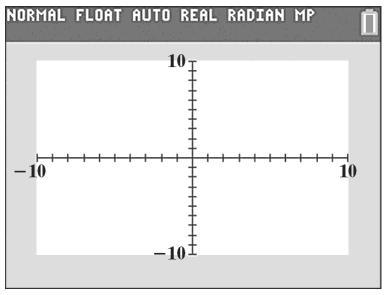
Section 2.2 Quadratic Functions Chapter 2 Polynomial and Rational Functions 283 Copyright © 2018 Pearson Education, Inc. Copyright © 2018 Pearson Education, Inc. 283 a. You can only see a little of the parabola.
d. You can choose Xmin and Xmax so the x-value of the vertex is in the center of the graph Choose
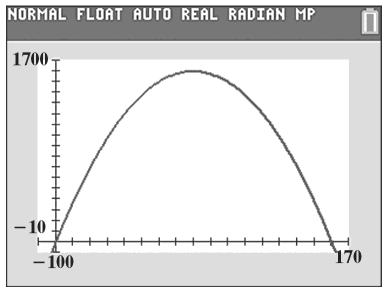

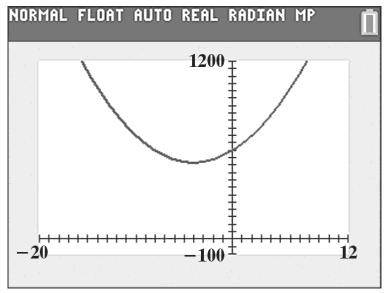
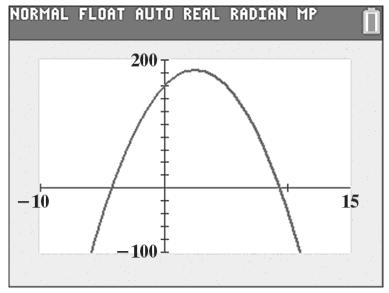
include
9 – 18 + 100 = 91
89. a. The values of y increase then decrease
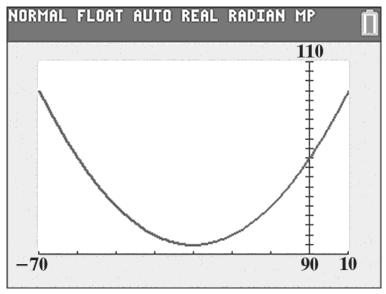
Section 2.2 Quadratic Functions Chapter 2 Polynomial
284 Copyright © 2018 Pearson Education, Inc. Copyright ©
Education, Inc. 284
a =2; b = –
x = b 82 = 20.5 87. y = 5x 2 + 40x + 600 x = b = 40 = 4 = 2a 4 2a 10 y = 2(20.5)2 82(20.5)
720 y = 5(–4)2 + 40(–4) + 600 =840.5 1681+
= 120.5 = 80 – 160 + 600 = 520 vertex: (–4, 520) vertex: (20.5,
and Rational Functions
2018 Pearson
b.
82
+
720
–120.5)
c. Ymax = 750
vertex 85. y = –0.25x 2 + 40x x = b = 40 =80 88. y = 0.01x 2 + 0.6x + 100 2a 0.5 b 0.6 y = –0.25(80)2 + 40(80) = 1600 x = = = 30 2a 0.02 2 vertex: (80, 1600) y = 0.01(–30) + 0.6(–30) + 100 86. y = –4x 2 + 20x + 160 x = b = 20 = 2.5 =
The vertex is
Ymin to
the y-value of the
at (–30, 91).
2a 8 y = –4(2.5)2 + 20(2 5)
= –2.5 +
=
The vertex is at (2.5,
b. y = 0.48x 2 +6.17x +9.57
x =
≈ 6
+ 160
50 +160
185
185)
c.
(6.17)
Section 2.2 Quadratic Functions Chapter 2 Polynomial and Rational Functions 285 Copyright © 2018 Pearson Education, Inc. Copyright © 2018 Pearson Education, Inc. 285 2( 0.48) y = 0.48(6)2 +6.17(6)+9 57 ≈ 29.3 According to the model in part (b), American Idol had the greatest number of viewers, 29.3 million, in Season 6.
d. The greatest number of viewers actually occurred in Season 5, not Season 6, and the model underestimates the greatest number by
97. false; Changes to make the statement true will vary. A sample change is: The x-coordinate of the
e. Scatter plot and quadratic function of best fit: coordinate of the vertex of the parabola is
90. does not make sense; Explanations will vary.
Sample explanation: Some parabolas have the y-axis as the axis of symmetry.
91. makes sense
92. does not make sense; Explanations will vary.
98. f(x) = 3(x + 2)2 – 5; (–1, –2) axis: x = –2 (–1, –2) is one unit right of (–2, –2). One unit left of (–2, –2) is (–3, –2). point: (–3, –2)
99. Vertex (3, 2) Axis: x = 3 second point (0, 11)
100. We start with the form f ( x)= a ( x h)2 + k
Since we know the vertex is (h, k )=( 3, 4) , we path will be a line segment. have f
Sample explanation: If it is thrown vertically, its
93. does not make sense; Explanations will vary.
Sample explanation: The football’s path is better described by a quadratic model.
94. true
95. false; Changes to make the statement true will vary. A sample change is: The vertex is (5, 1).
96. false; Changes to make the statement true will vary. A sample change is: The graph has no x–intercepts. To find x–intercepts, set y = 0 and solve for x.
( x +4)2 8
Because the solutions to the equation are imaginary, we know that there are no x–intercepts.
4 We also know that the
graph passes through the point (1,4), which allows us to solve for a 2
Therefore, the function is ( ) ( )2 2
101. We know (h, k )=( 3, 4) , so the equation is of the 2
form f ( x)=
We use the point ( 2, 3) on the graph to determine

Section 2.2 Quadratic Functions Chapter 2 Polynomial and
Functions 286 Copyright ©
Education, Inc.
286
Rational
2018 Pearson
Copyright © 2018 Pearson Education, Inc.
1 1 1
b
= = =
–2a 2( 1) 2 2
1 1 million. maximum is
and the y
f b = f 1 = 5 2a 2 4
maximum y–
5
4
The
value is
.
x)=
(x +3
(
a
)2
4 = a (1+3) 4 8 = a (4)2 8 =16a 1 = a 2 f x = 1 x +3 4
0
2
=
2
x +4)2 = 8
a
2 ( x +4)2 = 4 = a x ( 3) 2 +( 1)
(
(x h) + k
= a ( x +3) 1


































